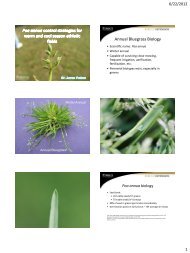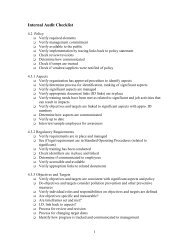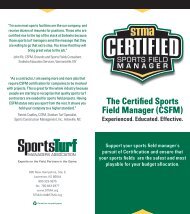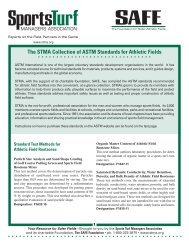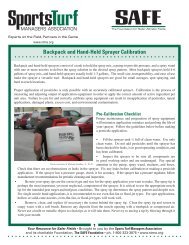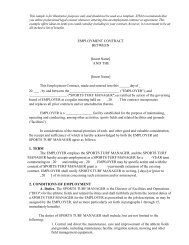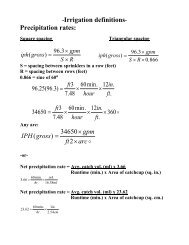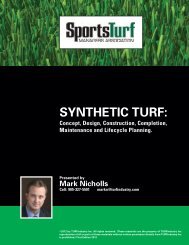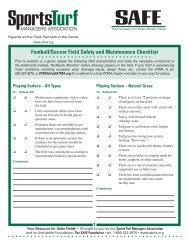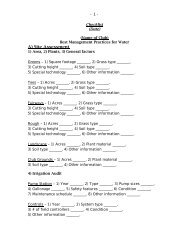Winter Athletic Field Maintenance Calendar for the ... - STMA
Winter Athletic Field Maintenance Calendar for the ... - STMA
Winter Athletic Field Maintenance Calendar for the ... - STMA
You also want an ePaper? Increase the reach of your titles
YUMPU automatically turns print PDFs into web optimized ePapers that Google loves.
<strong>Winter</strong> <strong>Athletic</strong> <strong>Field</strong> <strong>Maintenance</strong> <strong>Calendar</strong> <strong>for</strong><strong>the</strong> Transition Zone: December – FebruaryDisease TriangleDiseases occur when three factors are present and meet <strong>the</strong>correct conditions.1) A susceptible host – The grass plants are <strong>the</strong> hosts;choose resistant and/or tolerant varieties wheneverpossible.2) A virulent pathogen – The disease-incitingorganism is almost always present in <strong>the</strong> soiland not causing problems. However, conditionssometimes change and it can attack <strong>the</strong> turf.3) A suitable environment – When certainenvironmental conditions are present, disease mayoccur. For example, hot, humid wea<strong>the</strong>r oftencontributes to <strong>the</strong> appearance of some diseases.Pink snow mold• Symptoms – Circular areas of turf turn tan, lightgray, or orange-brown. Fluffy mycelium may bepresent that appears pink in sunlight. Snow doesnot need to be present <strong>for</strong> development.• Prevention – Avoid heavy applications of quickrelease nitrogen in late fall. Keep turf height lowto prevent leaves from matting. If <strong>the</strong> field hasa history of snow mold, a preventative fungicideapplication can be applied just be<strong>for</strong>e <strong>the</strong> firstsignificant snowfall.Chemical ControlProper mowing, irrigation, fertilization, and cultivationcan all lead to a healthy, dense field that is able towithstand moderate disease infestations. Unless fieldshave a history of poor disease tolerance, in order to abideby IPM standards, preventative fungicide applications areoften not necessary. If <strong>the</strong> field is affected by a disease, acurative application should be sufficient.If turf blankets are being used, carefully monitor <strong>the</strong> area<strong>for</strong> disease. Warm, wet wea<strong>the</strong>r during <strong>the</strong> winter canincrease <strong>the</strong> likelihood <strong>for</strong> disease appearance. Fungicideapplications may be necessary depending on winterwea<strong>the</strong>r.Symptoms and Preventative MeasuresGray snow mold• Symptoms – Circular areas of turf turn yellow orgray/brown. Wet leaves become matted toge<strong>the</strong>rand are covered with gray or white mycelium. Dryleaves are gray and brittle with no mycelium. Adefining characteristic is <strong>the</strong> small, hard, roundsclerotia on infected leaves. They can be white,pink, brown or black. Gray snow mold requiressnow <strong>for</strong> development..• Prevention – Avoid heavy applications of quickrelease nitrogen in late fall. Avoid excessivethatch and prevent compaction. Keep turf heightlow to prevent leaves from matting. Promote aircirculation in early spring by removing snow andensuring proper drainage.Off Season <strong>Maintenance</strong><strong>Winter</strong> is also a great time to devote to equipmentmaintenance and repair. <strong>Maintenance</strong> to prepare <strong>for</strong> <strong>the</strong>upcoming spring season can include, sharpening mowerblades, oil changes, routine inspection and safety checks,cleaning, and o<strong>the</strong>r major repairs. Proper equipmentmaintenance and care prolongs <strong>the</strong> life of equipmentand saves money in <strong>the</strong> long run. If equipment is notfunctioning properly, winter may be a good time to replaceand upgrade your inventory.Conducting routine field and facility safety checks areimportant throughout <strong>the</strong> year. However, busy sportsand maintenance schedules can sometimes compete withtasks on <strong>the</strong> priority list. Take this opportunity to checkyour fields and surrounding facility <strong>for</strong> any necessarymaintenance to prepare <strong>for</strong> <strong>the</strong> upcoming season.11Your Resource <strong>for</strong> Safer <strong>Field</strong>s • Brought to you by <strong>the</strong> Sports Turf Managers Associationand its charitable Foundation, The SAFE Foundation • ph. 1-800-323-3875 • www.stma.org



